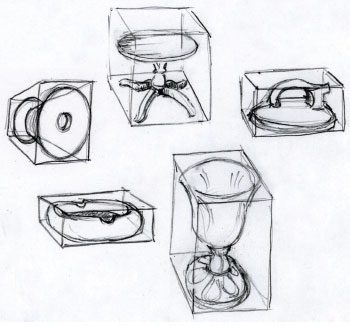Once you can draw a box in one, two, and three point perspective …
… you can draw most anything, because any three dimensional object will have a top, bottom, and sides.
Therefore, even if it doesn’t look like a box, it can be put into a box and the rules of foreshortening and convergence will still apply.
For example, try drawing boxes at several different angles and points of view.
Now draw a cat in each box. The cat is in no way flat on the sides like a box, yet having the box drawn is a definite help because the box gives you a sense of space in the picture plane, and the height and width dimensions act as guidelines for the back, head, body and legs.
Try this activity with several non-box objects, as well as with those countless objects that are, roughly or precisely, squares or rectangles. Even round objects can be put into boxes, which is very helpful to remember as you practice drawing circles, spheres, and cones.
Want To Learn More…
Perspective is the set of techniques that anyone involved in representational drawing uses to transpose a 3D scene onto a 2D format.
Or in simple words, it’s how you make your drawings look real!
You have to study it and know the principles if you have any chance at all of bringing our drawings to life.
Learning perspective is a fundamental element that you need to master before you can draw like a true professional.
The good news is that Perspective Mastery is generously illustrated showing you step-by-step how to make your drawings come to life.
With clear (and fun) instructions on how to draw … you’ll learn at your own pace in the comfort of your home.




